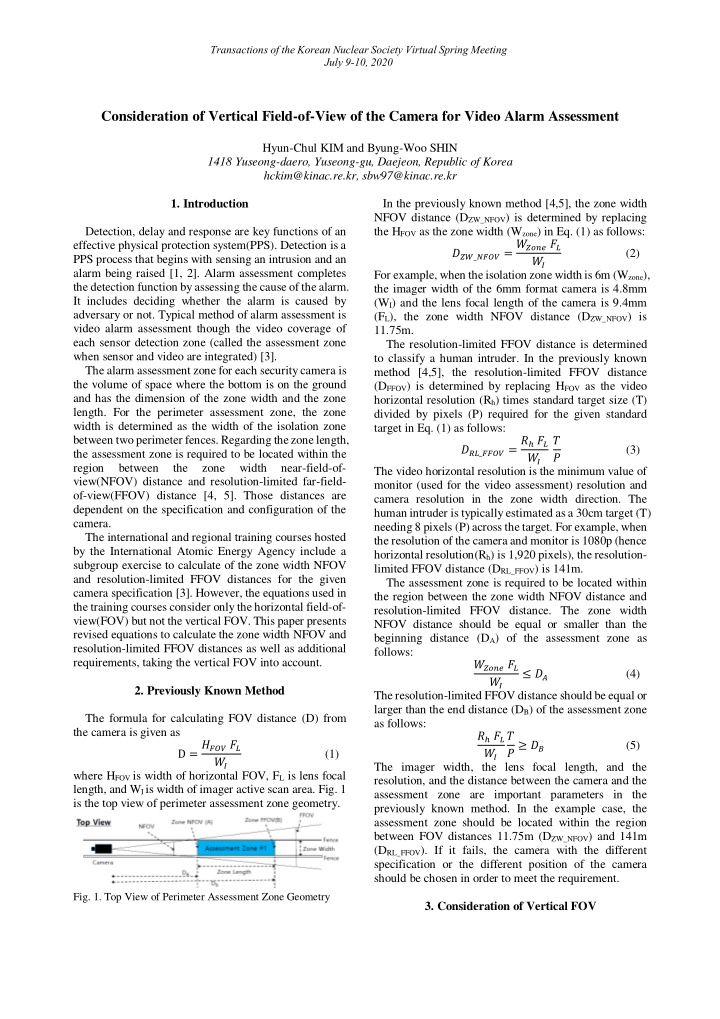



Transactions of the Korean Nuclear Society Virtual Spring Meeting July 9-10, 2020 Consideration of Vertical Field-of-View of the Camera for Video Alarm Assessment Hyun-Chul KIM and Byung-Woo SHIN 1418 Yuseong-daero, Yuseong-gu, Daejeon, Republic of Korea hckim@kinac.re.kr, sbw97@kinac.re.kr 1. Introduction In the previously known method [4,5], the zone width NFOV distance (D ZW_NFOV ) is determined by replacing Detection, delay and response are key functions of an the H FOV as the zone width (W zone ) in Eq. (1) as follows: 𝐸 𝑎𝑋_𝑂𝐺𝑃𝑊 = 𝑋 𝑎𝑝𝑜𝑓 𝐺 effective physical protection system(PPS). Detection is a 𝑀 (2) PPS process that begins with sensing an intrusion and an 𝑋 𝐽 alarm being raised [1, 2]. Alarm assessment completes For example, when the isolation zone width is 6m (W zone ), the detection function by assessing the cause of the alarm. the imager width of the 6mm format camera is 4.8mm It includes deciding whether the alarm is caused by (W I ) and the lens focal length of the camera is 9.4mm adversary or not. Typical method of alarm assessment is (F L ), the zone width NFOV distance (D ZW_NFOV ) is video alarm assessment though the video coverage of 11.75m. each sensor detection zone (called the assessment zone The resolution-limited FFOV distance is determined when sensor and video are integrated) [3]. to classify a human intruder. In the previously known The alarm assessment zone for each security camera is method [4,5], the resolution-limited FFOV distance the volume of space where the bottom is on the ground (D FFOV ) is determined by replacing H FOV as the video and has the dimension of the zone width and the zone horizontal resolution (R h ) times standard target size (T) length. For the perimeter assessment zone, the zone divided by pixels (P) required for the given standard width is determined as the width of the isolation zone target in Eq. (1) as follows: 𝐸 𝑆𝑀_𝐺𝐺𝑃𝑊 = 𝑆 ℎ 𝐺 𝑈 between two perimeter fences. Regarding the zone length, 𝑀 (3) the assessment zone is required to be located within the 𝑋 𝑄 𝐽 region between the zone width near-field-of- The video horizontal resolution is the minimum value of view(NFOV) distance and resolution-limited far-field- monitor (used for the video assessment) resolution and of-view(FFOV) distance [4, 5]. Those distances are camera resolution in the zone width direction. The dependent on the specification and configuration of the human intruder is typically estimated as a 30cm target (T) camera. needing 8 pixels (P) across the target. For example, when The international and regional training courses hosted the resolution of the camera and monitor is 1080p (hence by the International Atomic Energy Agency include a horizontal resolution(R h ) is 1,920 pixels), the resolution- subgroup exercise to calculate of the zone width NFOV limited FFOV distance (D RL_FFOV ) is 141m. and resolution-limited FFOV distances for the given The assessment zone is required to be located within camera specification [3]. However, the equations used in the region between the zone width NFOV distance and the training courses consider only the horizontal field-of- resolution-limited FFOV distance. The zone width view(FOV) but not the vertical FOV. This paper presents NFOV distance should be equal or smaller than the revised equations to calculate the zone width NFOV and beginning distance (D A ) of the assessment zone as resolution-limited FFOV distances as well as additional follows: requirements, taking the vertical FOV into account. 𝑋 𝑎𝑝𝑜𝑓 𝐺 𝑀 ≤ 𝐸 𝐵 (4) 𝑋 𝐽 2. Previously Known Method The resolution-limited FFOV distance should be equal or larger than the end distance (D B ) of the assessment zone The formula for calculating FOV distance (D) from as follows: the camera is given as 𝑆 ℎ 𝐺 𝑈 𝑀 D = 𝐼 𝐺𝑃𝑊 𝐺 𝑄 ≥ 𝐸 𝐶 (5) 𝑀 𝑋 (1) 𝐽 𝑋 𝐽 The imager width, the lens focal length, and the where H FOV is width of horizontal FOV, F L is lens focal resolution, and the distance between the camera and the length, and W I is width of imager active scan area. Fig. 1 assessment zone are important parameters in the is the top view of perimeter assessment zone geometry. previously known method. In the example case, the assessment zone should be located within the region between FOV distances 11.75m (D ZW_NFOV ) and 141m (D RL_FFOV ). If it fails, the camera with the different specification or the different position of the camera should be chosen in order to meet the requirement. Fig. 1. Top View of Perimeter Assessment Zone Geometry 3. Consideration of Vertical FOV
Recommend
More recommend